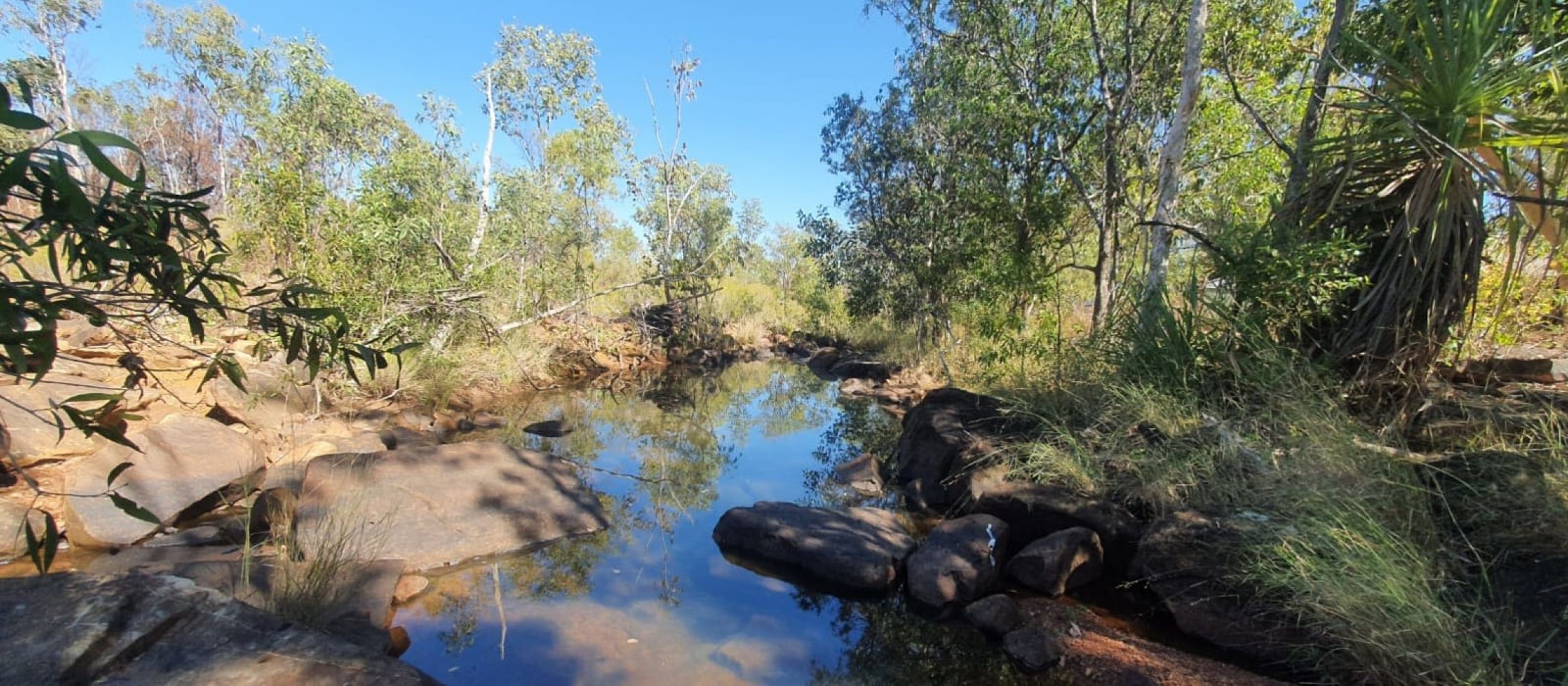
The most common fish we never expected to find

Kerry Mazzotti
The Spangled Perch (Leiopotherapon unicolour) is Australia’s most widespread freshwater fish. No one would be surprised to see its little silver body with distinctive reddish-brown spots in creeks, rivers, and waterholes across Australia. But Dr Michael Hammer and Dr Glenn Moore never thought they would find it on today’s fishing trip in the Prince Regent Catchment.
I was lucky enough to join them on my final field day of Bush Blitz. The helicopter roared to life at 8am with me, the scientists, Fiona (Bush Blitz Teacher), Pilot Sam and George the Electro Fisher on board. We flew north over the Kimberley savannah until we reached the rugged country of the Prince Regent Catchment. Gorges came into view with their hostile burnt amber cliffs and deep green gullies. Dr Michael and Dr Glenn love sampling fish at waterfall sites. They look for differences in species and populations they find above the waterfall and below the waterfall. It ensures they have the best job in the world, electro fishing in some of the most beautiful landscapes on the planet.
Pilot Sam lowered us expertly down on a rocky platform in the middle of the gorge. We jumped out, unloaded the gear, and waved him goodbye as the sand was whipped up around us by the leaving helicopter. I was in awe at my surroundings. The gentle sound of the purest water in the world bubbling gently over black rocks, the bright green of the Pandanus reflecting off the deep rockpools.
“Dingo!” Shouts Fiona, I turn around and see a dusty coloured dog slinking along the other side of the creek. It stops and looks at us inquisitively. Dr Glenn reminds us that we are in such a remote location that this dingo has probably never seen a human before. This is the second Dingo I have seen in the wild in my life, the other was a week ago on the road into Charnley River Station. What an epic adventure this has been.
Shortly after we arrive Dr Michael explains his Electro Fisher machine. Affectionately known as ‘George’, the Electro Fisher is worn as a backpack with a wand-like scoop net out the front that sends an electric zap through the water. The fish within a couple of metres of the wand are stunned but will recover after a minute or two. Dr Glenn trails behind with another net, scooping up fish and checking if they are target species. Target species are plopped into a bucket of water to take back to base camp and ultimately to the WA Museum collection.
The scientists in the water are protected from the electricity by rubber boots and waders and I am warned to keep my feet and hands out of the water to prevent getting a shock. I follow along taking photos of the fish caught, surprised at the diversity of colours and patterns in these freshwater fish.
Dr Glenn explained that they caught a species that is previously unrecorded in the Prince Regent Catchment, the twist being that it is the most common freshwater fish in Australia – the Spangled Perch. They were searching for a similar but much more rare species, the Kimberley Spangled Perch (Leiopotherapon macrolepis) which only occurs in the Prince Regent and Roe River Catchments of the north Kimberley region. Less than an hour later they had one in their scoop net. It is a pretty fish, a golden fish with reddish-orange fins and large scales. Dr Glenn declares it as his favourite freshwater fish of the Kimberley. The scientists never expected to find both fish in the same waterways.
Safely back at camp, we gathered after dinner and revised the field guide. Making notes and annotations and adding records from this trip. The capture of the most common freshwater fish in Australia means that the field guide will need to be rewritten. Bush Blitz demonstrates that science is not static, it is dynamic. The passion and dedication of research scientists means that every time we find an answer, we find another question and in this way the field grows, expands, and evolves.
The Prince Regent Catchment is one of the wildest, most remote places in the world. But we are not the first scientists on this land, and we will not be the last. As Tim Winton writes in the foreword to Dr Michael and Dr Glenn’s Field Guide “Aboriginal people have observed, collected and recorded the fish of the region for millennia, and modern science is only following in their footsteps to enlarge our knowledge of what swims and breeds in waterways”. There have been scientists on this land for thousands of years and with each Bush Blitz, each expedition, each day of field work, we are continuing the story of science that is as old as time.

